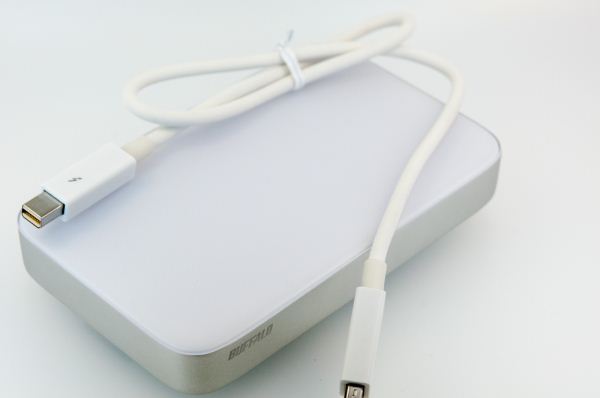Buffalo MiniStation Thunderbolt Review - An External with USB 3.0 and Thunderbolt
by Brian Klug on August 1, 2012 4:04 PM EST- Posted in
- Storage
- SSDs
- USB 3.0
- Thunderbolt
- Buffalo
The first Thunderbolt peripherals were primarily aimed at the very high end, as they were usually either RAID or JBOD solutions, with either a number of HDDs or SSDs and first generation Thunderbolt controllers. For the vast majority of customers, single drive solutions with much more modest price points were what everyone has been waiting for, and I strongly feel that the Buffalo MiniStation Thunderbolt is one such drive.
The combination of Apple-reminiscent industrial design, an affordable price point, and the option for either USB 3.0/2.0 and Thunderbolt as an interface makes it a no brainer for shoppers with both feet squarely in the Apple ecosystem. Even outside the Apple ecosystem, users with Z77 boards that include Thunderbolt will shortly be looking for drives and enclosures that allow them to use the new interface. In addition, a number of previous drives haven’t been nearly as portable as the MiniStation Thunderbolt is in practice, which is a one-piece solution that’s powered entirely over either USB2.0/3.0 or Thunderbolt.

As Apple moves to a platform that increasingly is flash-only, albeit with less overall storage, external mass storage will start becoming important once again. Buffalo feels that it’s here they can win with the MiniStation Thunderbolt for iTunes and Video collections that users will stick on external storage. Whether that comes true or the cloud-centric, thin client as a cache model wins out is still something that remains to be seen. As a drive, however, the MiniStation Thunderbolt is an excellent use of what boils down to the current fastest external interface, even if it isn’t over fiber, yet.











61 Comments
View All Comments
VKone - Friday, August 3, 2012 - link
Hi there,I assume it´s possible to boot from this TB drive to OS X.
How about booting to Win7 or Win 8. As far as I recollect, this has not been possible in the past with Firewire Drives. Does it work with TB now?
Thanks, CXC
munsie - Monday, August 13, 2012 - link
It would depend on if the BIOS supported it or not. Since a drive connected up via TB looks like another SATA drive connected to a PCIe bridge, the OS shouldn't care. But if the BIOS doesn't even look for bootable drives on SATA ports that aren't on the motherboard, it won't matter.I think, but haven't verified myself, that any Apple machine with TB can boot Windows over TB.
serons - Friday, August 3, 2012 - link
Why are the controller chips in the cable and not in the devices that it connects?repoman27 - Friday, August 3, 2012 - link
The controllers are in the devices, not the cables.The cables are active, however, and have several small chips in each connector which help compensate for various signaling issues. This allows the use of thinner, more flexible, stranded conductors and can lower overall power consumption. Active cables are fairly common at signaling rates of 10.3125 GBaud.
Everyone seems to think Thunderbolt cables are expensive because they are active, but even passive twinax cables that can handle 2x 10 Gbps channels are pretty pricey.
End User - Friday, August 3, 2012 - link
I was tickled pink when I popped a M4 into a $10 OKGEAR USB 3.0 case. Amazing how cheap things have become. That OKGEAR case certainly makes the MiniStation look a tad pricey but price is not the only factor I go by.I bought the 1TB as soon as I finished the review. My 11" MBA has just 2 USB 3.0 ports so it will be nice to be able to connect a third drive. I can also connect it to the Thunderbolt port on my P8Z77-V PREMIUM.
AnTech - Sunday, August 5, 2012 - link
"Thunderbolt is in practice, which is a one-piece solution that’s powered entirely over either USB2.0/3.0 or Thunderbolt."What???
AnTech - Sunday, August 5, 2012 - link
Mechanism inside? RPM? Sustained (read true) transfer rates (read & write)?Please, bring 2 x Thunderbolt + USB 3 ports for both 750 MB 2.5-inch mobile and 4 TB 3.5-inch desktop drives.
sarangiman - Friday, October 5, 2012 - link
Has anyone tested to see if the Buffalo Ministation works reliably over Thunderbolt (or USB) with a larger capacity SSD, e.g. a 512GB (Samsung 830) or a 480GB (Intel 520) SSD?There was some talk that the power requirement of larger drives would cause disconnections over Thunderbolt in such enclosures, e.g. using the Seagate Portable Thunderbolt adapter.
Thanks in advance!
VKone - Monday, December 10, 2012 - link
I´d also like to know. Any news on that?klutzak5 - Thursday, February 21, 2013 - link
Well, I can seemingly answer this question. I have tried 2 separate Crucial M4 512GB SSDs. and they have both crapped out spectacularly.They initially format and work for a very short period of time. After which, the drives begin to disconnect after around 3 to 4 GB of sustained transfer. These disconnects happen reliably for a while and then the drive refuses to mount.
Attempting to re-initialize the drives will fail with a 'cannot write to last block' error in Mountain Lion. The drives are, for all intents and purposes; hosed.
I thought the first time this happened I had a faulty SSD. Then it happened with the next drive.
So I would say, based on my experience, that you should stay away from 512 GB SSDs, unless you want to run the risk of a $350 to $400 mistake.